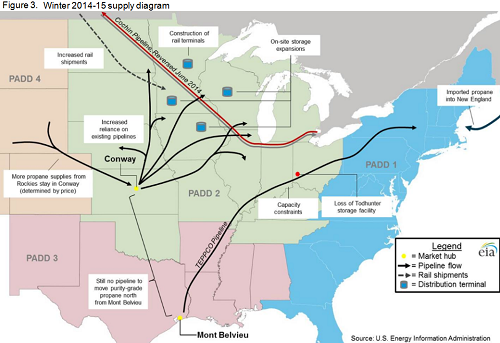Propane uses, especially Midwestern farmers, are hoping to avoid a repeat of last winter’s high prices, low inventories and logistical and infrastructure challenges that caused some real problems last year. The latest information from the U.S. Energy Information Administration shows that while inventories are below average, they’re above the numbers from a year ago and are trending upwards in the last few weeks.
While inventory levels in the Midwest remain below the five-year average, above-average builds over the past six weeks are an encouraging trend. Last year, propane inventories in the Midwest (PADD 2) for the week ending August 9 were 21.5 million barrels, 3.4 million barrels below the five-year average. This year, PADD 2 propane inventories for the week ending August 8 are 23.4 million barrels, 1.9 million barrels higher than last year, but still 1.6 million barrels below the five-year average. However, in each of the past six weeks, PADD 2 propane inventory builds have surpassed their five-year averages, leading to a steady improvement in stock levels relative to their historical norms…

Last year, demand for propane used to dry crops in the Upper Midwest surged just before the start of winter and, as a result, propane inventories at distribution terminals were low before the start of winter heating season. In addition, distribution infrastructure challenges, pipeline maintenance, and rail delivery delays reduced supplies. This year, inventories are building earlier; however, there have been changes in infrastructure that could impact supply. The Cochin Pipeline, which delivered propane to the Upper Midwest from Canada, has been reversed and repurposed, removing a major source of propane supplies to the region.
Propane market participants have responded to the events of last winter and the Cochin reversal by diversifying supply sources. Instead of relying on propane delivered from Canada via Cochin, the region will now rely more on several existing pipelines to deliver propane north to the Upper Midwest from Conway. Additionally, propane rail capacity in the region has expanded via new propane rail terminals throughout the region. Finally, existing distribution terminals have added tanks, thus expanding storage capacity.
The report goes on to say that there will be continued infrastructure challenges for winter propane deliveries in the Midwest and the Northeast will have to rely on imports from Canada. In addition, an expected record corn harvest this year could put pressure on supplies again in the form of propane used for crop drying, but that will depend on fall weather patterns and harvest timing. How cold the winter is will as be the the most important and most difficult-to-predict factor influencing the propane supply-demand balance this winter.

